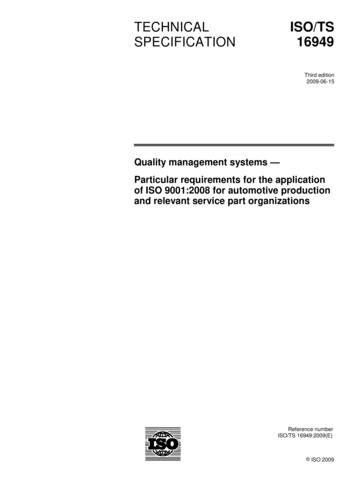
Transcription
ISO/TS16949TECHNICALSPECIFICATIONThird edition2009-06-15Quality management systems —Particular requirements for the applicationof ISO 9001:2008 for automotive productionand relevant service part organizationsReference numberISO/TS 16949:2009(E) ISO 2009
Introduction0.1 GeneralISO 9001:2008, Quality management systems — RequirementsIntroduction0.1GeneralThe adoption of a quality management system should be a strategic decision of an organization. The design andimplementation of an organization's quality management system is influenced bya)b)c)d)its organizational environment, changes in that environment, and the risks associated with that environment,its varying needs,its particular objectives,the products it provides,f)its size and organizational structure.e)the processes it employs,It is not the intent of this International Standard to imply uniformity in the structure of quality managementsystems or uniformity of documentation.The quality management system requirements specified in this International Standard are complementary torequirements for products. Information marked “NOTE” is for guidance in understanding orclarifying the associated requirement.This International Standard can be used by internal and external parties, including certification bodies,to assess the organization's ability to meet customer, statutory and regulatory requirements applicable to theproduct, and the organization's own requirements.The quality management principles stated in ISO 9000 and ISO 9004 have been taken into considerationduring the development of this International Standard.
0.2 Process approachISO 9001:2008, Quality management systems — Requirements0.2Process approachThis International Standard promotes the adoption of a process approach when developing, implementing andimproving the effectiveness of a quality management system, to enhance customer satisfaction bymeeting customer requirements.For an organization to function effectively, it has to determine and manage numerous linked activities. Anactivity or set of activities using resources, and managed in order to enable the transformation of inputs intooutputs, can be considered as a process. Often the output from one process directly forms the input to the next.The application of a system of processes within an organization, together with theidentification and interactions of these processes, and their management to produce the desired outcome, can bereferred to as the “process approach”.An advantage of the process approach is the ongoing control that it provides over the linkage between theindividual processes within the system of processes, as well as over their combination and interaction.When used within a quality management system, such an approach emphasizes the importance ofa)b)c)d)understanding and meeting requirements,the need to consider processes in terms of added value,obtaining results of process performance and effectiveness, andcontinual improvement of processes based on objective measurement.
The model of a process-based quality management system shown in Figure 1 illustrates theprocess linkages presented in Clauses 4 to 8. This illustration shows that customers play asignificant role in defining requirements as inputs. Monitoring of customer satisfaction requires theevaluation of information relating to customer perception as to whether the organization has met thecustomer requirements. The model shown in Figure 1 covers all the requirements of thisInternational Standard, but does not show processes at a detailed level.NOTE In addition, the methodology known as “Plan-Do-Check-Act” (PDCA) can be applied to all processes.PDCA can be briefly described as essarytodeliverresultsinaccordancewithcustomer requirements and the organization's policies.Do: implement the processes.Check: monitor and measure processes and product against policies, objectives and requirements for the product andreport the results.Act: take actions to continually improve process performance.Figure 1 — Model of a process-based quality management system
0.3 Relationship with ISO 9004ISO 9001:2008, Quality management systems — Requirements0.3Relationship with ISO 9004ISO 9001 and ISO 9004 are quality management systemdesigned to complement each other, but can also be used independently.standardswhichhavebeenISO 9001 specifies requirements for a quality management system that can be used for internal applicationby organizations, or for certification, or for contractual purposes. It focuses on the effectiveness ofthe quality management system in meeting customer requirements.At the time of publication of this International Standard, ISO 9004 is under revision. The revised edition ofISO 9004 will provide guidance to management for achieving sustained success for any organization in acomplex, demanding, and ever changing, environment. ISO 9004 provides a wider focuson quality management than ISO 9001; it addresses the needs and expectations of all interestedparties and their satisfaction, by the systematic and continual improvement of the organization’s performance.However, it is not intended for certification, regulatory or contractual use.NOTEThe knowledge and use of the eight quality management principles referred to in ISO 9000:2005 andISO 9004:— should be demonstrated and cascaded through the organization by top management.0.4 Compatibility with other management systemsISO 9001:2008, Quality management systems — Requirements0.4Compatibility with other management systemsDuring the development of this International Standard, due consideration was given to the provisions of ISO14001:2004 to enhance the compatibility of the two standards for the benefit of the user community.AnnexA shows the correspondence between ISO 9001:2008 and ISO 14001:2004.This International Standard does not include requirements specific to other management systems, such as thoseparticular to environmental management, occupational health and safety management, financialmanagement or risk management. However, this International Standard enables an organization to align orintegrate its own quality management system with related management system requirements. It is possiblefor an organization to adapt its existing management system(s) in order to establish a quality managementsystem that complies with the requirements of this International Standard.0.5 Goal of this Technical SpecificationThe goal of this Technical Specification is the development of a quality management system that provides forcontinual improvement, emphasizing defect prevention and the reduction of variation and waste in the supplychain.This Technical Specification, coupled with applicable customer-specific requirements, defines the fundamentalquality management system requirements for those subscribing to this Technical Specification.This Technical Specification is intended to avoid multiple certification audits and provide a common approachto a quality management system for automotive production, and relevant service part organizations.R
TECHNICAL SPECIFICATIONISO/TS 16949:2009(E)Quality management systems — Particular requirements for theapplication of ISO 9001:2008 for automotive production andrelevant service part organizations1Scope1.1 GeneralISO 9001:2008, Quality management systems — Requirements1 Scope1.1 GeneralThis International Standard specifies requirements for a quality management system where an organizationa) needs to demonstrate its ability to consistently provide product that meets customer andapplicable statutory and regulatory requirements, andb) aims to enhance customer satisfaction through the effective application of the system,including processes for continual improvement of the system and the assurance of conformity tocustomer and applicable statutory and regulatory requirements.NOTE 1 In this International Standard, the term “product” only applies toa)product intended for, or required by, a customer,b)any intended output resulting from the product realization processes.NOTE 2 Statutory and regulatory requirements can be expressed as legal requirements.This Technical Specification, in conjunction with ISO 9001:2008, defines the quality managementsystemrequirements for the design and development, production and, when relevant, installation andservice of automotive-related products.This Technical Specification is applicable to sites of the organization where customer-specifiedparts, for production and/or service, are emote(suchasdesign centres, corporateheadquarters and distribution centres), form part of the site audit as they support the site,but cannot obtain stand-alone certification to this Technical Specification.This Technical Specification can be applied throughout the automotive supply chain.1.2 ApplicationISO 9001:2008, Quality management systems — Requirements1.2 ationalStandardaregenericandareintendedtobeall organizations, regardless of type, size and product provided.1
ISO/TS 16949:2009(E)Where any requirement(s) of this International Standard cannot benature of an organization and its product, this can be considered for exclusion.appliedduetotheWhere exclusions are made, claims of conformity to this International Standard are not acceptable unless theseexclusions are limited to requirements within Clause 7, and such exclusions do not affectthe organization's ability, or responsibility, to provide product that meets customer and applicable statutory andregulatory requirements.The only permitted exclusions for this Technical Specification relate to 7.3 where the organization isnot responsible for product design and development.Permitted exclusions do not include manufacturing process design.2Normative referencesThe following referenced documents are indispensable for the application of this document.For dated references, only the edition cited applies. For undated references, the latestedition of the referenced document (including any amendments) applies.ISO 9000:2005, Quality management systems — Fundamentals and vocabulary3Terms and definitionsISO 9001:2008, Quality management systems — Requirements3Terms and definitionsFor the purposes of this document, the terms and definitions given in ISO 9000 apply.Throughout the text of this International Standard, wherever the term “product” occurs, it can also mean“service”.3.1 Terms and definitions for the automotive industryFor the purposes of this document, the terms and definitions given in ISO 9000:2005 and the following apply.3.1.1control plandocumented description of the systems and processes required for controlling productNOTESee Annex A.3.1.2design responsible organizationorganization with authority to establish a new, or change an existing, product specificationNOTEThis responsibility includes testing and verification of design performance within the customer's specifiedapplication.3.1.3error proofingproduct and manufacturing process design and development to prevent manufacture of nonconformingproducts3.1.4laboratoryfacility for inspection, test or calibration that may include,metallurgical, dimensional, physical, electrical or reliability testingbutisnotlimitedto,chemical,
ISO/TS 16949:2009(E)3.1.5laboratory scopecontrolled document containing specific tests, evaluations and calibrations that a laboratory is qualified to perform,a list of the equipment which it uses to perform the above, anda list of methods and standards to which it performs the above3.1.6manufacturingprocess of making or fabricating production materials, production or service parts, assemblies, or heat treating, welding, painting, plating or other finishing services3.1.7predictive maintenanceactivities based on process data aimed at the avoidance of maintenance problems by prediction of likely failuremodes3.1.8preventive maintenanceplanned action to eliminate causes of equipment failure and unscheduled interruptions to production, as anoutput of the manufacturing process design3.1.9premium freightextra costs or charges incurred additional to contracted deliveryNOTEThis can be caused by method, quantity, unscheduled or late deliveries, etc.3.1.10remote locationlocation that supports sites and at which non-production processes occur3.1.11sitelocation at which value-added manufacturing processes occur3.1.12special characteristicproduct characteristic or manufacturing process parameter which can affect safety or compliance withregulations, fit, function, performance or subsequent processing of product3
ISO/TS 16949:2009(E)4Quality management system4.1 General requirementsISO 9001:2008, Quality management systems — Requirements4Quality management system4.1 General requirementsThe organization shall establish, document, implement and maintain a quality management system andcontinually improve its effectiveness in accordance with the requirements of this International Standard.The organization shalla) determine the processes needed for the quality management system and their application throughout theorganization (see 1.2),b) determine the sequence and interaction of these processes,c) determine criteria and methods needed to ensure that both the operation and control of these processes areeffective,d) ensure the availability of resources and information necessary to support the operation and monitoring of theseprocesses,e) monitor, measure where applicable, and analyse these processes, andf) implement actions necessary to achieve planned results and continual improvement of these processes.These processes shall be managed by the organization in accordance with the requirementsof this International Standard.Where an organization chooses to outsource any process that affects product conformity to requirements,the organization shall ensure control over such processes. The type and extent of control to be applied to theseoutso
ISO/TS 16949:2009(E) 3.1.5 laboratory scope controlled document containing specific tests, evaluations and calibrations that a laboratory is qualified to perform, a list of the equipment which it uses to perform the above, and a list of methods and standards to which it performs the above 3.1.6 manufacturing process of making or fabricating production materials, production or service parts .
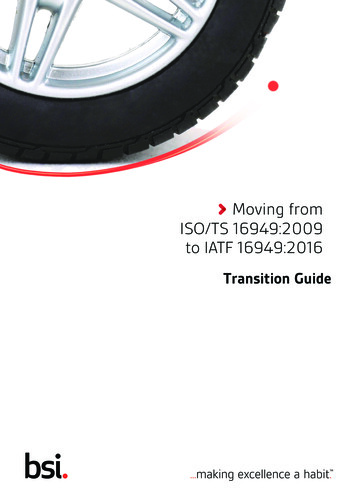
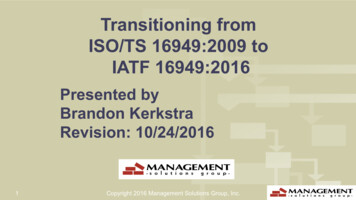

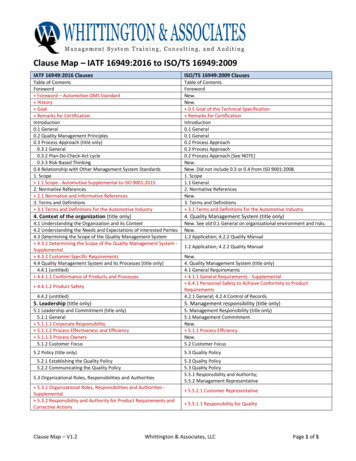
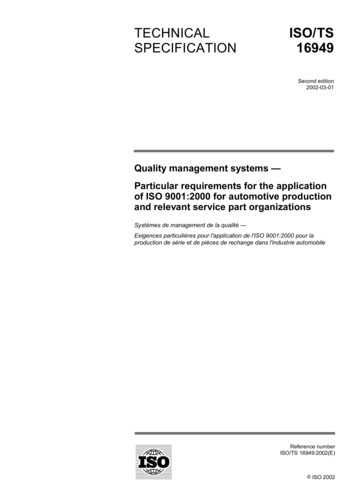

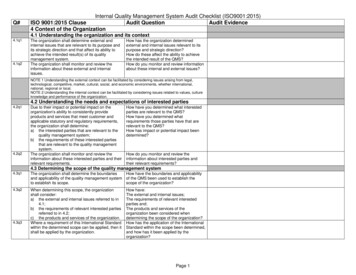
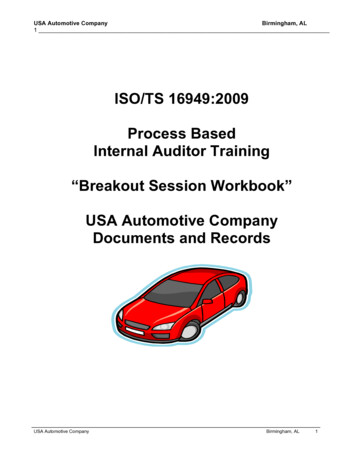
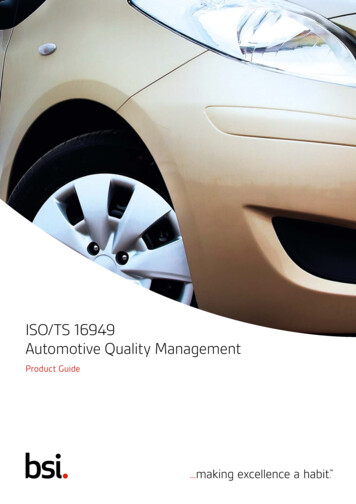
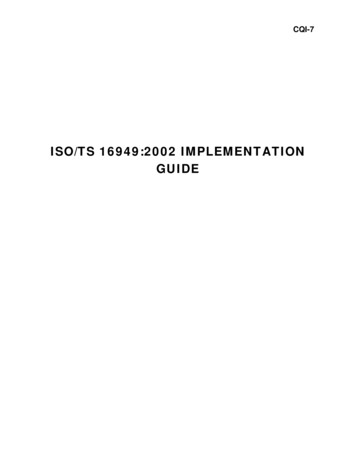
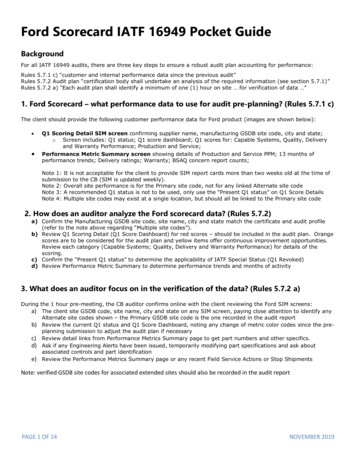
![[MS-ADTS-Diff]: Active Directory Technical Specification](/img/1/ms-adts-170316-diff.jpg)